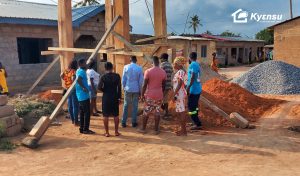The Youth for Water and Climate Platform showcased at COP26
From October 31st to November 12th, thousands of world leaders, young people, women, indigenous people, business leaders and scientists from around the world convened in Glasgow for the 26th United Nations Climate Change conference to discuss the future of our planet.
Following two weeks of intense negotiations, the Glasgow Climate Pact has been signed by over 200 nations. This Pact urges “Parties and stakeholders to ensure meaningful youth participation and representation in multilateral, national and local decision-making processes”. It also acknowledged the obvious: “the current provision of climate finance for adaptation remains insufficient to respond to worsening climate change impacts in developing country Parties”.
The Youth for Water and Climate Platform was showcased as a good practice in the field of youth, water & finance during two sessions co-organized by the International Secretariat for Water, the Global Water Partnership, Ooska News, GWP-CEE and the World Federation of Engineering Organisations at the Water Pavilion and the Resilience Hub during COP26.
These sessions highlighted the fact that we need innovative financing mechanisms adapted to the situation of young leaders from communities around the world to allow them to gain access to finance.

As mentioned by Sarah Dousse, Executive Director of the International Secretariat for Water, during the session held in the Resilience Hub, “youth face a technical and financial and technical gap to successfully implement their solutions as they are often marginalized and excluded from funding opportunities”.
In fact, many of the larger multilateral funds are not adapted to the needs and specific situations of young people. Caroline Fouvet, Climate Finance Analyst at Willis Towers Watson, mentioned that “there’s a big disconnect between the international climate landscape and the people on the ground who want to receive the money and implement projects. There is a disconnect between the small-scale ideas and the large-scale ideas which the GCF wants to fund.”
When asked what can be done to fill this gap, Fouvet states that “it goes both ways, there’s capacity-building that is needed for young people and for organisations. Platforms such as the Youth for Water and Climate Platform is a good step.”
Several projects funded by the Youth for Water and Climate platform such as the Kyensu Project, Keep Nati Clean and the Mother Earth Project were presented during these sessions, showcasing the true impact which young people can have in their own communities when given the financial and technical support needed.

“We like to consider young people as observers. We are not just observers. We can bring something to the table. We, young people in Africa need to be mentored. We need to be supported and accompanied.”, says Michèle Nken, Regional Youth Program Coordinator at Global Water Partnership – Central Africa.
By continuing to expand and develop partnerships and collaborations with the public and private sector, the International Secretariat for Water and the Global Water Partnership look forward to using the Youth for Water and Climate Platform to mobilize additional funding and technical support for young leaders in the field of water and climate.

“Without the youth there is no way to address the climate challenge. We need to build these legions of people that will come up behind us and change the world into a climate aligned positive world. I pledge that I will continue to spread that message amongst my peers.”, says Stacy Swann, CEO Climate Finance Advisors.
Reflecting on the outcomes of COP26, Elysa Vaillancourt, Youth Project Manager at the International Secretariat for Water, feels that a step in the right direction has been taken regarding the inclusion of the voices of youth in the decision-making processes regarding climate as well as in the recognition of the importance of mobilizing adaptation finance for the most vulnerable and marginalized communities.
The presence of the first-ever Water Pavilion during COP26 also shed light on the fact that water is not only the primary medium through which we are already feeling the effects of climate change, it is also the key element which will allow us to build climate resilience.
